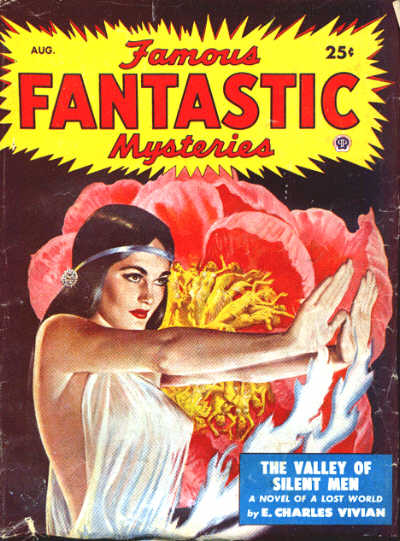 First appeared in Famous
Fantastic Mysteries, reprinted by Roger Elwood, Vic Ghidalia, Stefan R.
Dziemianowicz, Robert E. Weinberg and Martin H. Greenberg.
First appeared in Famous
Fantastic Mysteries, reprinted by Roger Elwood, Vic Ghidalia, Stefan R.
Dziemianowicz, Robert E. Weinberg and Martin H. Greenberg.
Summary:
“Sandy” Sanderson, art director, and Mopsa Hansen discuss
the horrible art work in Glowing Skull
Magazine, their competitor. All that they can appreciate about the work are
the long, frightening teeth. Unfortunately, the artist, Jabez Ordway, is soon
commissioned to do all further art work for Sanderson’s magazine. Worse, he
starts to make passes at all the women who work on the magazine, threatening
them with his occult powers if they don’t give in.
Commentary with Spoilers:
At first Sandy goes along with this as Ordway seems
tractable and doesn’t often draw the improbable monsters he drew for Glowing Skull. As Ordway seems to have a
measure of control over his cousin who owns the magazine, and as Sandy just
invested in a cabin, he feels he has to give in. But when Ordway threatens the
women, and even Sandy himself if he doesn’t auto-approve Ordway’s suddenly
turning in a set of lousy monster pictures.
So Sandy defenestrates Ordway. Mopsa helps support Sandy
with an alibi, so that it looks like suicide. Except that Sandy keeps dreaming
of Ordway. Sandy doesn’t sleep well, and finally seeks Mopsa’s grandmother who
is a white witch and comes up with a counter charm, which might help
temporarily, but it might be turned against him. Sandy promises not to use it
unless he has to. When he dreams Ordway standing at his bed, Sandy takes the
charm, but it backfires, leaves him trapped in one of the worst of Ordway’s
drawings, hearing a rustle in the grass pursuing wherever he goes.
This story is interesting in that St. Clair was Wiccan and
that the ending, which at first we feel is unfair, turns out to be apropos when
pondered. Not the best of her best, but it definitely needs inclusion in her
selected works. Apart from the plot shift of killing the antagonist, pushing us
into new speculative territory in a short story, this tale is surprisingly
simple for St. Clair. But she kept the plot moving into interesting territory when lesser writers might have settled on something easy.
Nonetheless, the story has possibly the worst line in St.
Clair’s career: “His Adam’s apple was throbbing incoherently.” Were I to
reprint this, I might accidentally leave out this line.

No comments:
Post a Comment